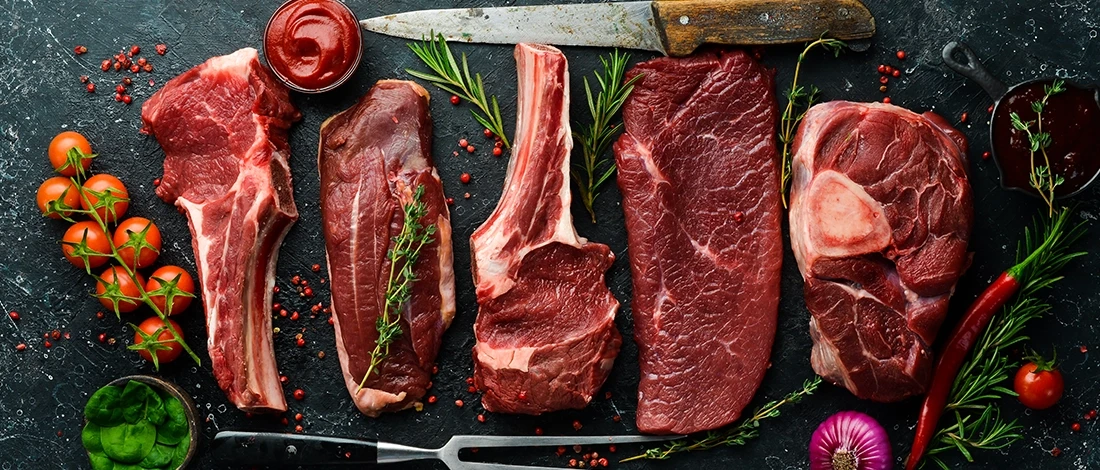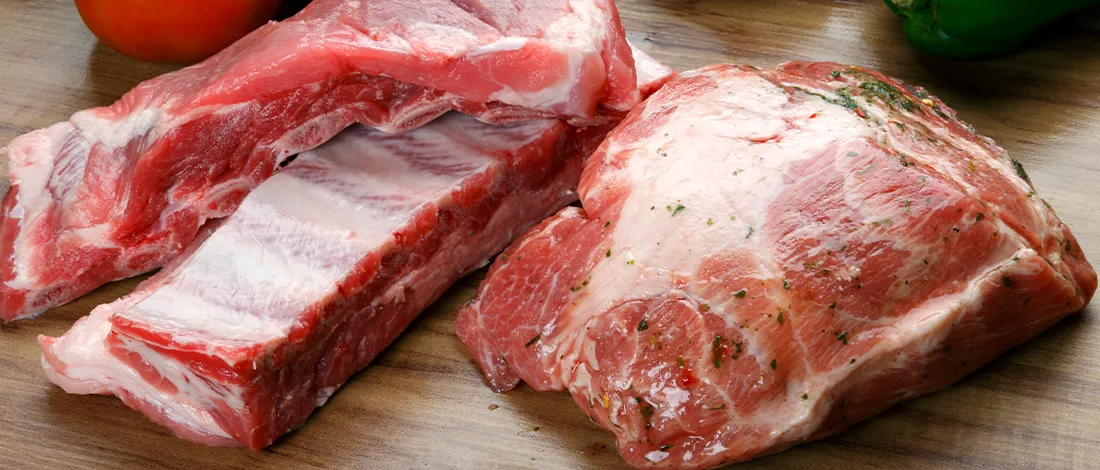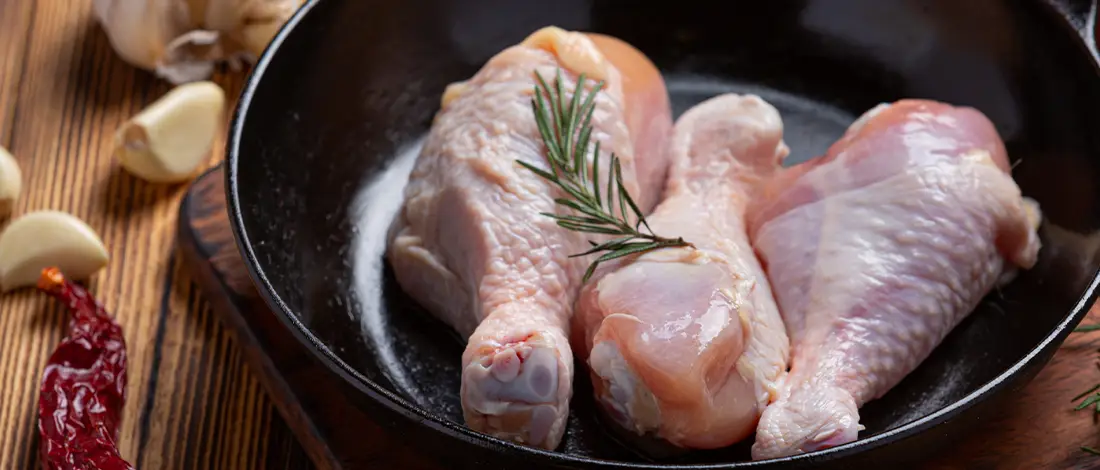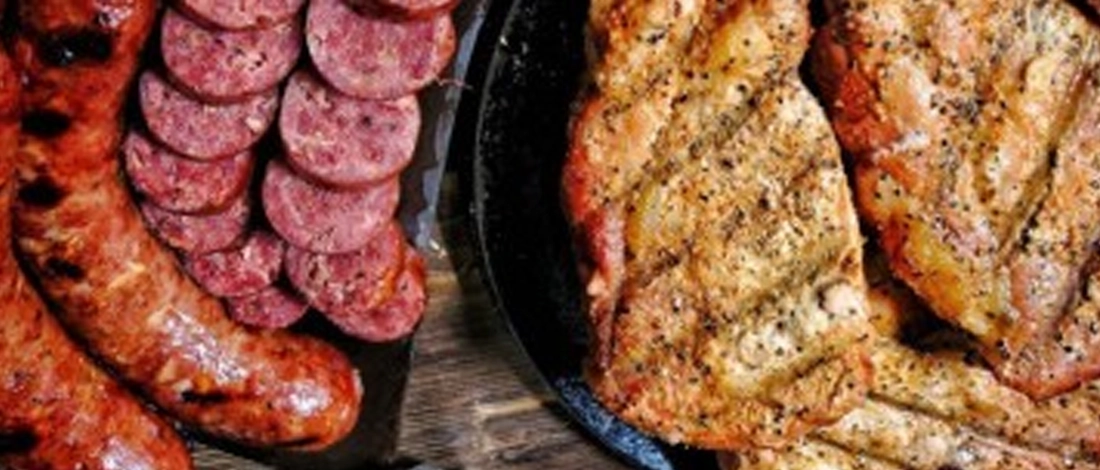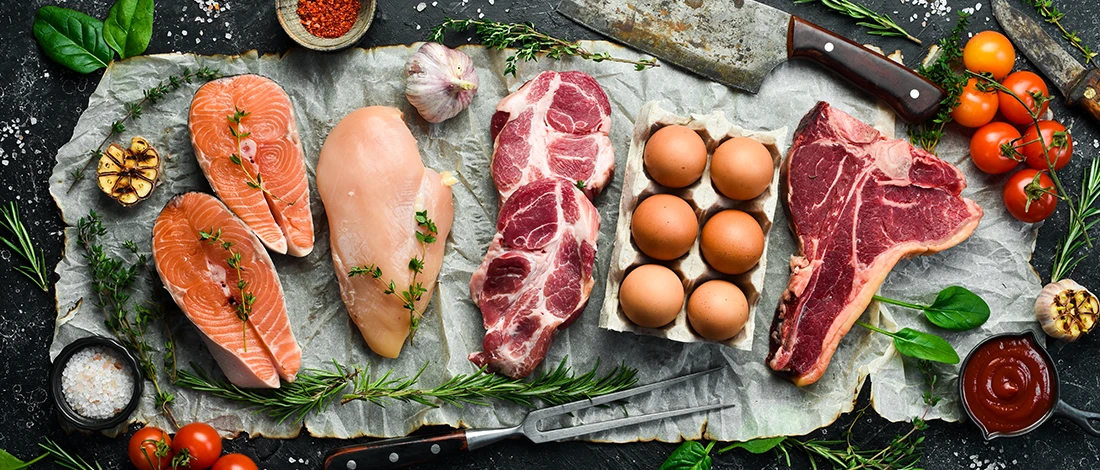As a dedicated carnivore lifestyle devotee, I’m always stocked on pork, which has been my basic kitchen staple for years.
At Carnivore Style, we know that mastering your knowledge of pork cuts can take your carnivore meals to the next level.
Learning all the ins and outs of pork cuts took me some time and several conversations with my butcher, who was eager to share the important details with me and provide me with valuable insight.
Today, I’ll enlist different cuts of pork and everything else you need to know to become an expert in this area.
Quick Summary
- Pork is divided into primal and subprimal cuts.
- There are multiple subprimal cuts of pork, such as pork roast, shoulder, loin, ribs, and many more.
- You should know how to cook each cut of pork for the most delicious results.
- The most important part of getting tender and flavorful pork is having quality cuts, such as those sold by ButcherBox.
The Primal Pork Cuts

When you buy pork from a butcher, it’s already broken down for cooking at home. Americans consume over 50 pounds of pork a year per capita, so pork for home use is in high demand [1].
But, before the pork is cut down, it’s divided into primal and subprimal cuts.
These are the primal cuts:
- Shoulder — It encompasses the front part of the pig. The upper part can also be called the butt, and the front leg is the picnic.
- Leg — This is the hind leg and the rump. The ham comes from this part of the pig, so the pork leg section is also called the ham.
- Loin — This is the middle part of the pig, and it’s made up of the top, also called the loin. The loin is a very tender and lean cut.
- Belly — This is the bottom part of the middle of the pig. It’s also called the side and is the fattiest part of the pig’s meat.
Subprimal Types of Pork Cuts

Subprimal cuts of pork are smaller than primal cuts but still relatively large. These cuts can be sold as a whole or cut down into smaller cuts, especially for pork retail.
Subprimal cuts of pork are commonly found at supermarkets and butcher shops.
Each subprimal cut has unique features, flavor, and texture, so you need to choose the preparation method accordingly.
Here’s a complete breakdown of subprimal cuts.
1. Pork Chops
Pork chops are the most popular cut of pork. They come from the loin (the part of the meat that goes from the pig’s hip to the shoulder).
Different cuts are called pork chops. You can also find it under the name:
- Pork loin chops — These have a T-shaped bone on the side and are called pork loin end chops, pork chop end cut, loin pork chops, or pork center loin chops.
- Pork rib chops — Also called pork rib cut chops.
- Pork top loin chops — Also called pork strip chops. It can be sold boneless.
All of these are cooked the same. You can grill, broil, air fry, or pan-fry boneless pork chops. The cooking duration depends on the chop thickness and the chosen method.
Tip: Thicker pork chops that have the bone attached are the juiciest and most flavorful.
Read More: Can Pork Chops Be a Little Pink?
2. Pork Loin
Pork loin cuts are the leanest and the most tender cut of pork. You have to make sure not to overcook the loin.
There are three sections of the pork loin:
- Blade end — Closest to the shoulder and usually fatty
- Sirloin end — Closest to the rump and usually bony
- Center portion — In the middle, and is the leanest and the most expensive part.
Tip: You can buy loin roasts boneless or bone-in. Buy the loin without the bones because it’s easiest to slice.
“When buying pork, look for cuts with a relatively small amount of fat over the outside and with meat that is firm and a grayish-pink color. For best flavor and tenderness, meat should have a small amount of marbling.”
- FDA
The loin has a dense texture and a mild flavor with a cap of fat from the back. It’s most commonly stuffed and cooked as a roast or closed into small chops for frying and grilling.
3. Pork Tenderloin
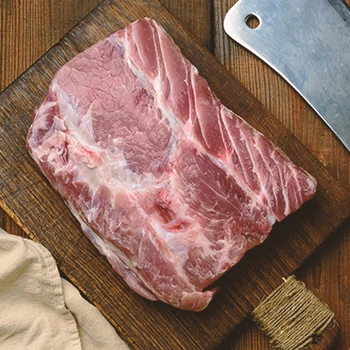
Pork tenderloin is another very popular cut of pork. Next to loin chops, it’s also the most expensive.
Tenderloin cuts are lean, boneless, and tender. This cut is easy to cook. You can grill, roast, or broil it, but it’s very easy to overcook, so you have to be careful.
Tenderloin is pale pink, has a fine grain, and is smaller than pork loin roast.
Note: Tenderloins can be sold with a silverskin still attached, which you should remove before cooking.
4. Pork Belly
A pork belly is a boneless cut of pork. Contrary to the name, the belly doesn’t come from the pig’s stomach but from the underside after removing the loin and spareribs. It comes from the part of the pig that runs on the belly and surrounds the stomach.
Pork belly has a rich flavor and is served in small portions. It’s the most tender with a slow cooking method, such as braising. You can also roast it, smoke, sear, or use it to make homemade bacon.
Read More: Pork Belly Bao Buns Recipe
5. Pork Shoulder Chops
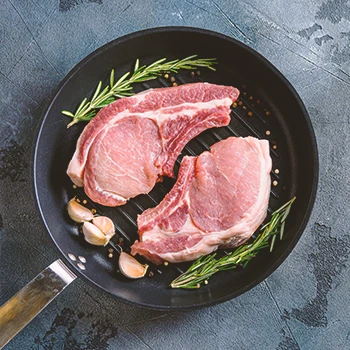
Pork shoulder chops are also sold as blade chops, pork butt, Boston butt, picnic roast, and more. This cut comes from the blade roast and is fatty and tougher compared to other kinds of chops.
This is a great budget cut if you like pulled pork and stew. Pork shoulder is larger, tougher, and fattier than tenderloin and chops. But once you cook it, you’ll get tender and juicy meat full of flavor.
Note: Pork shoulder can also be sold as pork butt, and it’s sold boneless or bone-in and weighs between five and ten pounds.
You can grill, broil, or pan-fry them. I like to marinade this cut to make it tender. You can also braise or use it in a stew.
Generally, pork shoulder requires a long cooking time — up to eight hours when cooked on low and up to five hours when cooked on high to break the connective tissue. The meat is done when it reaches the temperature of 145 degrees [2].
6. Pork Cutlets
Pork cutlets are boneless cuts, also called boneless chops. This is a lean cut of pork. It’s usually used to make steaks similar to sirloin chops but somewhat meatier and boneless. Medallions are also made from cutlets.
You should pound cutlets before cooking to make them thin. Then coat them in breadcrumbs and pan-fry. Or, you can bake or sear them on a pan or a grill.
7. Ham
Ham comes from the pig’s hind leg, specifically the top part. It’s cured and smoked and can be boneless or bone-in, but you can also find fresh and boiled ham.
Note: Jamon serrano and prosciutto are salt-and-air-cured hams.
Boneless hams are more commonly available. These are easier to cook and serve. You can cook a spiral-sliced fresh ham in a shallow pan for about 10 minutes per pound. You can also bake a partially cooked ham for 20 minutes per pound.
8. Bacon
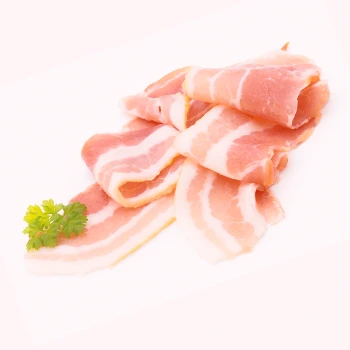
There are several kinds of bacon you can buy. The most usual type of bacon is made from fatty slabs from the pig’s underbelly and then smoked and cured with salt, which concentrates the flavor.
There’s also leaner Canadian bacon which is cut from the loin and served in cylindrical slices. Pancetta is cut from the belly and cured but isn’t smoked.
Bacon has a longer shelf-life than uncured pork. You can keep it in the fridge for a week or in the freezer for months.
9. Country-Style Ribs
Country-style ribs are also called loin ribs. These are the meatiest and fattiest of all types of pork ribs. These ribs are cut from where the loin and shoulder join, so it’s a combination of high-fat and lean meat.
They are available both bone-in and boneless and are served as both slabs and individual servings. You can eat these ribs with a knife and fork or off the bone.
10. Pork Sausage
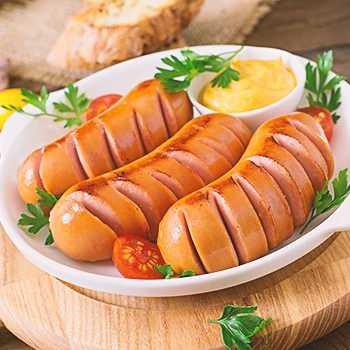
Most sausages are made from ground pork. Some sausages are available fresh, and you have to cook them, while others are already cooked, smoked, or cured and only need to be sliced or heated.
Sausage flavor can go from sweet to savory and spicy. You can also make a sausage according to your flavor preferences by using ground pork and spices.
Sausage can be grilled, roasted, sauteed, or used in a stew. It’s also commonly used as a pizza topping. Cook sausage to 160 degrees to make sure it’s done [3].
11. Pork Baby-Back Ribs
Baby-back ribs are also commonly called pork back ribs. These ribs are meatier compared to spare ribs but not as meaty as country-style ones.
Baby-back ribs come from the pig’s rib cage near the backbone. They are sweet and juicy and cook quickly.
One full rack has at least eight ribs, and it’s best roasted or grilled.
12. Pork Spare Ribs
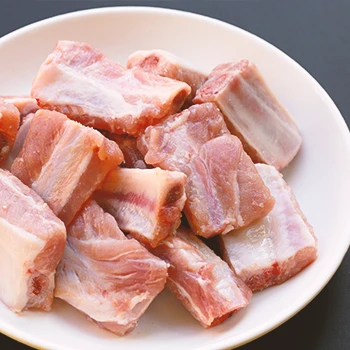
Spare ribs also come from the pig’s belly and are famous for their rich flavor. These ribs are larger than other kinds of pork ribs. They have a tender-chewy texture.
Each spare rib is large and has an irregular shape because of a large amount of fat. A full rack has at least 11 ribs, which is enough for about three people.
Spare ribs taste great when roasted, grilled, or braised. They are best when you do the slow-cooking process to make them tender. You can brown the whole slab of ribs under the broiler and then bake low and slow.
13. Pork Roasts

Different cuts can be sold as pork roast, such as:
- Blade roasts — It’s fattier than other roasts but less expensive.
- Pork rib roast — Is the pork equivalent to a standing beef rib roast or a rack of lamb? It’s called pork center loin roast and is fattier than tenderloin but still lean. It’s juicy and flavorful meat. You can cook it with fat on top and remove the fat after cooking for very juicy and tender meat.
- Top loin roast — Comes from part of the pig between the shoulder and the start of the leg. It’s sold boneless and bone-in, but bone-in is usually juicier. Don’t confuse it with tenderloin, which is the smaller and longer cut. You can brine or rub with spices and then barbecue over the heat.
- Sirloin roast — Less expensive than tenderloin. You should ask the butcher to remove the bone because it’s difficult to carve.
14. Pork Hock
Hock is also called pork shank, and it comes between the picnic shoulder and the hog’s lower leg. This is a tough and muscled cut, but it’s economical.
It’s best cooked using slow-cooking methods to break the connective tissue so you have tender meat.
15. Pork Knuckles and Trotters
Knuckles and trotters need slow cooking methods to make them tender. Otherwise, they are tough.
These cuts are sought for their meaty flavor.
16. Pork Lard
Lard technically isn’t a cut of pork, but it’s rendered fat from pork. You can use it in the same way as cooking oil or fat.
Pork lard has a neutral flavor, so you can use it when baking for a flaky pie crust.
Related Articles:
FAQs
What Are the Four Major Cuts of Pork?
The four major cuts of pork are shoulder, leg, point, and belly.
What Cut of Pork Is the Best?
Pork tenderloin is the best cut of pork. This is the most tender cut, and you can give it added flavor by using marinade, rubs, and spices.
What Is the Cheapest Pork Cut?
The cheapest pork cut is pork shoulder, pork ribs, and pork loin.
At Carnivore Style, we want to help you become confident in choosing and cooking pork cuts. Check out our other guides for more tips on making the most of your carnivore diet.
References:
- https://www.statista.com/statistics/183616/per-capita-consumption
- https://www.fsis.usda.gov/food-safety/safe-food-handling-and-preparation/meat/
- https://www.pork.org/cuts/sausage/


